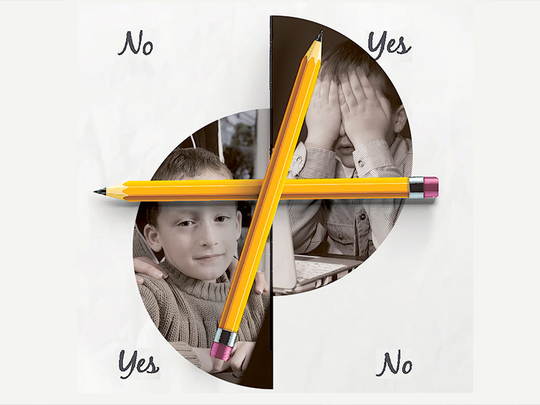
Dubai: This year witnessed a string of dangerous challenges and dares shared on social media, such as The Charlie Challenge and The Plastic Bag Challenge, that kept many parents wondering about the safety of their children. The current lull on social media in this regard gives the space to examine the dangers posed by such dares.
According to experts, the thrill and excitement these challenges promise, put children and adolescents under a threat every time such a dare goes viral.
The fact that it is dull season on dares right now is, however, no guarantee that they will not strike sooner or later. Parents need to stay alert all the time, keeping an eye on what their children are being drawn into, experts said.
Take the Kylie Jenner challenge earlier this year that went viral on social networks, challenging girls to stick their lips into a glass and then suck out the air. Why? To get larger, read more pouty, lips.
Then came the Charlie Charlie challenge. Children all over the world, even in the UAE, were caught up in the game believing that they can summon a demon who will answer their questions.
There was the Cinnamon Challenge, asking users to swallow a tablespoon of cinnamon powder in 60 seconds without any liquids. One of those meaningless challenges.
Worst of all was the Plastic Bag challenge, where people were asked to hold a plastic bag over their head and breathe heavily inside it for as long as they could in an attempt to raise awareness on animals dying of asphyxiation and money to save them. The fact that people could harm themselves in this process wasn’t, obviously, a thought worth considering.
The Plastic Bag Challenge made people believe that for every minute of their PBC experience, the World Wildlife Fund would donate 5 euros (Dh20). The World Wildlife Fund publicly condemned the game and said it was designed to kill.
Online trends playing with children’s minds
Dr. T.S. Arulparithi, a paediatrician at Aster Medical Centre, said the consequences of these high-risk stunts have a great influence on the physical and mental development of children who, in many situations, do not have enough decision-making capabilities to discern the inherent dangers of such dares.
“[In the Kylie Jenner Challenge, for instance], using the glass in the prescribed manner to acquire a pout can cause bruises to the mouth due to the pressure or the glass can break and injure the lips,” said Dr Arulparithi. “And in the Charlie Charlie Challenge, kids and teens can be made to believe in superstitions. They can also be subject to hallucinations, for example, with the false perception of a demon when no such things exist. Such things can have long-lasting consequences,” he said.
As for the Plastic Bag Challenge, breathing heavily into a plastic bag has fatal consequences, said Dr Arulparithi, as it reduces oxygen supply and can be specifically dangerous for people with asthma or heart disease.
The Cinnamon Challenge can clog the airway and cause damage to the lungs if inhaled.
He advised parents to keep a close eye on their children and watch their online activity while also opening a channel of communication between them.
Dr Valeria Risoli, clinical psychologist at Dubai Physiotherapy and Family Medicine Clinic, explained that children can do anything to try to fit in and controlling their access to internet has become close to impossible in this age.
“Kids are curious and, unfortunately, today, they are often and easily bored. They are constantly in search of something new and more stimulating [physically and mentally] to do,” she said.
Unfortunately, teens, who are rely on social media to communicate and interact these days, do not realise that a click or a share online of an image or a post of these trends contributes to the creation of these trends and has a very negative impact, she said. Sometimes, it can be potentially life-threatening, on themselves and other people too.
“Kids and teens feel cool if they have new topics to share with others or if they can challenge peers with something new that others don’t know yet. Unfortunately, they are easy targets,” said Dr Risoli.
School is the environment where kids spend most of their time, she said, and it is expected that these disturbing trends are discussed or shared at school as well.
Implications and intervention
Negative social media trends damage children’s social and emotional development
They can also cause anxiety disorders or physical damage
What can parents do?
Intervention is key, Dr Risoli says
Parental supervision and involvement in their children’s life is the first step, she says.
- 1 Be involved in your child’s life as much as possible. Understand your child’s mind, identify their feelings, promote social abilities and positive relationships, and prevent them from getting in contact with material and people that could be psychologically damaging for them.
- 2 Both at school and home, childen should be educated about the dangers of the internet, and the risk and damage that certain activities can cause to their mental and physical well-being. Keeping children or teenagers away from internet access is not a solution.
- 3 Work to build a close and trusting relationship with your children.
- The five key approaches: Prevention; Preparation; Explanation; Supervision; Hands-on approach, and Complete Awareness. These can yield good results and help children respond to such dares with more maturity.
- 4 It is essential to set boundaries and rules at home and school for children regarding use of social media. Being more aware of the possible disciplinary consequences could help as well in terms of prevention of certain dangerous behaviours.
- 5 Parents must support their kids and help them improve their self-worth and esteem, considering that children with low self-esteem and social insecurity are more likely to be influenced by others and follow dangerous trends in search of social recognition and acceptance.
Parentspeak
Samar Al Sabban, an Egyptian mother of two, said she noticed that a lot of her 13-year-old daughter’s friends shared similar links on their Facebook pages. “When the Charlie Charlie challenge appeared and my kids were curious to know whether the demon would appear, I explained to them that it was nonsense and then they dropped the subject. They were caught between being scared and also curious to see whether the challenge works or not. It was affecting them psychologically.”
Samar says she tries her best to communicate with them and make them trust her judgement when they have any questions or doubts.
Rana Al Mokayad, a Jordanian mother of four, says she tries to strike a balance between keeping her children on trend and monitoring the platforms they use and content they access.
Her 14-year-old daughter is not allowed to use anything but YouTube and WhatsApp to communicate with her friends and always seeks out her mum when she has queries about online content.
Rana says when her children hear about something new, they always tell her about it and she warns them if there is anything wrong. “This approach is better than punishing them the first time for something they did not have the cognitive maturity to understand,” she says.
Dr Risoli supports approaches by parents such as Samar and Rana and recommends all parents take such steps to help children feel comfortable sharing their stories and asking for advice from their parents.








